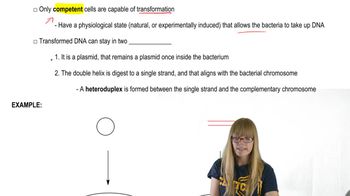Here are the essential concepts you must grasp in order to answer the question correctly.
Griffith's Experiment
Frederick Griffith conducted experiments in 1928 using two strains of Streptococcus pneumoniae: a virulent strain (smooth) and a non-virulent strain (rough). He discovered that when he injected mice with heat-killed virulent bacteria mixed with live non-virulent bacteria, the mice developed pneumonia and died. This indicated that some 'transforming principle' from the dead bacteria had transformed the non-virulent strain into a virulent one.
Recommended video:
Transformation
Transformation is a process in which a bacterium takes up foreign DNA from its environment and incorporates it into its own genome. In Griffith's experiment, the non-virulent bacteria acquired the genetic material from the heat-killed virulent bacteria, leading to the expression of virulence. This concept laid the groundwork for understanding how genetic information can be transferred between organisms.
Recommended video:
Avery-MacLeod-McCarty Experiment
Building on Griffith's findings, the Avery-MacLeod-McCarty experiment in 1944 identified DNA as the 'transforming factor.' They demonstrated that only DNA from the heat-killed virulent bacteria could transform the non-virulent strain, providing strong evidence that DNA is the molecule responsible for heredity. This experiment confirmed Griffith's initial observations and established DNA as the genetic material.
Recommended video:





